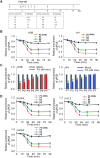Poly(ADP-ribosyl)ation mediates early phase histone eviction at DNA lesions
- PMID: 31965183
- PMCID: PMC7102957
- DOI: 10.1093/nar/gkaa022
Poly(ADP-ribosyl)ation mediates early phase histone eviction at DNA lesions
Abstract
Nucleosomal histones are barriers to the DNA repair process particularly at DNA double-strand breaks (DSBs). However, the molecular mechanism by which these histone barriers are removed from the sites of DNA damage remains elusive. Here, we have generated a single specific inducible DSB in the cells and systematically examined the histone removal process at the DNA lesion. We found that histone removal occurred immediately following DNA damage and could extend up to a range of few kilobases from the lesion. To examine the molecular mechanism underlying DNA damage-induced histone removal, we screened histone modifications and found that histone ADP-ribosylation was associated with histone removal at DNA lesions. PARP inhibitor treatment suppressed the immediate histone eviction at DNA lesions. Moreover, we examined histone chaperones and found that the FACT complex recognized ADP-ribosylated histones and mediated the removal of histones in response to DNA damage. Taken together, our results reveal a pathway that regulates early histone barrier removal at DNA lesions. It may also explain the mechanism by which PARP inhibitor regulates early DNA damage repair.
© The Author(s) 2020. Published by Oxford University Press on behalf of Nucleic Acids Research.
Figures






Similar articles
-
ADP-ribosylation of histone variant H2AX promotes base excision repair.EMBO J. 2021 Jan 15;40(2):e104542. doi: 10.15252/embj.2020104542. Epub 2020 Dec 2. EMBO J. 2021. PMID: 33264433 Free PMC article.
-
Poly-ADP ribosylation in DNA damage response and cancer therapy.Mutat Res Rev Mutat Res. 2019 Apr-Jun;780:82-91. doi: 10.1016/j.mrrev.2017.09.004. Epub 2017 Sep 20. Mutat Res Rev Mutat Res. 2019. PMID: 31395352 Free PMC article. Review.
-
Poly(ADP-ribosyl)ation enhances nucleosome dynamics and organizes DNA damage repair components within biomolecular condensates.Mol Cell. 2024 Feb 1;84(3):429-446.e17. doi: 10.1016/j.molcel.2023.12.019. Epub 2024 Jan 11. Mol Cell. 2024. PMID: 38215753
-
Histone ADP-ribosylation promotes resistance to PARP inhibitors by facilitating PARP1 release from DNA lesions.Proc Natl Acad Sci U S A. 2024 Jun 18;121(25):e2322689121. doi: 10.1073/pnas.2322689121. Epub 2024 Jun 12. Proc Natl Acad Sci U S A. 2024. PMID: 38865276 Free PMC article.
-
Relation between carcinogenesis, chromatin structure and poly(ADP-ribosylation) (review).Anticancer Res. 1991 Mar-Apr;11(2):489-527. Anticancer Res. 1991. PMID: 1905900 Review.
Cited by
-
Neuroprotective Effects of PARP Inhibitors in Drosophila Models of Alzheimer's Disease.Cells. 2022 Apr 9;11(8):1284. doi: 10.3390/cells11081284. Cells. 2022. PMID: 35455964 Free PMC article.
-
Unravelling the Role of PARP1 in Homeostasis and Tumorigenesis: Implications for Anti-Cancer Therapies and Overcoming Resistance.Cells. 2023 Jul 21;12(14):1904. doi: 10.3390/cells12141904. Cells. 2023. PMID: 37508568 Free PMC article. Review.
-
Cooperative targeting of PARP-1 domains to regulate metabolic and developmental genes.Front Endocrinol (Lausanne). 2023 Jun 6;14:1152570. doi: 10.3389/fendo.2023.1152570. eCollection 2023. Front Endocrinol (Lausanne). 2023. PMID: 37347109 Free PMC article.
-
The multifaceted role of PARP1 in RNA biogenesis.Wiley Interdiscip Rev RNA. 2021 Mar;12(2):e1617. doi: 10.1002/wrna.1617. Epub 2020 Jul 12. Wiley Interdiscip Rev RNA. 2021. PMID: 32656996 Free PMC article. Review.
-
Metaboloepigenetics in cancer, immunity, and cardiovascular disease.Cardiovasc Res. 2023 Mar 31;119(2):357-370. doi: 10.1093/cvr/cvac058. Cardiovasc Res. 2023. PMID: 35389425 Free PMC article. Review.
References
Publication types
MeSH terms
Substances
Grants and funding
LinkOut - more resources
Full Text Sources
Research Materials

